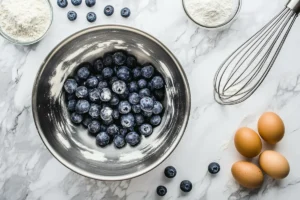Do Blueberry Muffins Have Any Protein? A Complete Nutritional Guide
Blueberry muffins are a beloved treat, often enjoyed for their sweet, fruity flavor and soft, fluffy texture. But have you ever wondered, do blueberry muffins have any protein? While they’re not typically known as a protein powerhouse, these muffins do contain some protein, thanks to ingredients like eggs, milk, and flour. In this article, we’ll dive deep into the protein content in blueberry muffins, explore how different recipes affect their nutritional value, and even share tips to make them a healthier snack. Whether you’re a muffin lover or just curious about their nutritional profile, this guide has you covered!
Introduction to Blueberry Muffins and Their Nutritional Profile
What Makes Blueberry Muffins So Popular?
Blueberry muffins are a staple in bakeries and home kitchens alike. Their sweet and tangy flavor, combined with a moist crumb, makes them irresistible. However, they’re often seen as a guilty pleasure rather than a nutritious snack. But here’s the thing: do blueberry muffins have any protein? The answer might surprise you!
Why Protein Content in Baked Goods Matters
Protein is a crucial macronutrient that supports muscle repair, keeps you full, and balances your diet. While muffins aren’t usually associated with high protein, understanding their protein content can help you make smarter choices. For instance, adding protein-rich ingredients can turn a simple muffin into a more satisfying snack.
In the next section, we’ll break down the key ingredients in blueberry muffins and how they contribute to their protein levels. Stay tuned to learn how to make your muffins not just delicious but also nutritious!
Nutritional Breakdown of Blueberry Muffins
What’s Inside a Blueberry Muffin?
When you bite into a blueberry muffin, you’re enjoying a mix of flour, sugar, eggs, milk, and, of course, blueberries. But have you ever stopped to think about how these ingredients contribute to the protein content? Let’s break it down:
- Flour: While all-purpose flour isn’t a major protein source, it still adds about 3-4 grams of protein per cup. Whole wheat flour, on the other hand, can bump that up to 6-8 grams, making it a healthier alternative.
- Eggs: These are the real MVP when it comes to protein in muffins. One large egg packs about 6 grams of protein, and most recipes call for at least one egg. Some recipes even use two, doubling the protein contribution.
- Milk: Whether you use dairy or plant-based milk, this ingredient adds a small but meaningful amount of protein. For example, cow’s milk provides about 8 grams of protein per cup, while soy milk offers a similar amount. Almond milk, however, has only 1 gram per cup, so choose wisely if you’re aiming for higher protein levels.
- Blueberries: While they’re not a protein-rich food, they bring antioxidants and fiber to the table, making your muffin a bit more nutritious overall.
Protein Sources in Blueberry Muffins
So, do blueberry muffins have any protein? Absolutely! The protein content primarily comes from eggs and milk. For example, a standard homemade blueberry muffin contains around 4-6 grams of protein. That’s not a huge amount, but it’s enough to make a difference in your daily intake.
If you’re looking to boost your protein levels, consider using Greek yogurt or protein powder in your recipe. Greek yogurt, for instance, adds about 10 grams of protein per half-cup, while a scoop of whey protein powder can contribute an additional 20-25 grams. These swaps can significantly increase the protein content without sacrificing flavor.
How Does a Blueberry Muffin Compare to Other Snacks?
Let’s put things into perspective. A typical blueberry muffin has about the same protein content as a slice of whole-grain bread or a small handful of nuts. While it’s not a high-protein snack, it’s certainly not protein-free. For more insights on protein-rich foods, check out this guide from Healthline.
The Role of Sugar and Calories in Blueberry Muffins
While we’re on the topic of nutrition, it’s worth mentioning that blueberry muffins can be high in sugar and calories. A store-bought muffin, for example, might contain 20-30 grams of sugar and 400+ calories. By making your muffins at home, you can control these factors and create a healthier version. For instance, reducing the sugar by half and using natural sweeteners like honey or mashed bananas can make a big difference.
Factors Affecting Protein Content in Blueberry Muffins
Homemade vs. Store-Bought: Which Has More Protein?
When it comes to protein in blueberry muffins, not all muffins are created equal. Homemade muffins often have a slight edge because you can control the ingredients. For instance, adding an extra egg or using protein-rich flour can boost the protein content.
On the other hand, store-bought muffins tend to focus more on shelf life and sweetness than nutrition. As a result, they often have less protein and more sugar. If you’re curious about the nutritional data for store-bought muffins, the USDA FoodData Central is a great resource.
Gluten-Free and Vegan Options: Do They Have Protein?
If you’re following a gluten-free or vegan diet, you might wonder if your muffins can still pack a protein punch. The good news is, yes! Ingredients like almond flour, chia seeds, and soy milk can make your muffins both delicious and nutritious.
For example, almond flour contains about 6 grams of protein per quarter-cup, making it a fantastic alternative to regular flour. Similarly, soy milk adds about 7 grams of protein per cup, compared to just 1 gram of almond milk. Chia seeds are another great option, offering 4 grams of protein per tablespoon.
How to Boost Protein in Your Blueberry Muffins
Want to turn your muffins into a high-protein snack? Here are some easy tips:
- Add a scoop of protein powder to the batter. This is one of the simplest ways to increase protein levels without altering the texture too much.
- Use Greek yogurt instead of regular milk or butter. Not only does it add protein, but it also keeps the muffins moist and tender.
- Mix in chopped nuts or seeds for an extra crunch and protein boost. Walnuts, almonds, and sunflower seeds are all excellent choices.
- Experiment with alternative flours like chickpea flour or quinoa flour, which are naturally higher in protein.
The Impact of Baking Methods on Protein Content
Did you know that the way you bake your muffins can also affect their protein content? Overbaking can cause proteins to denature, reducing their nutritional value. To preserve the protein, bake your muffins just until a toothpick inserted into the center comes out clean. This ensures they’re cooked through without losing their nutritional benefits.
Health Benefits of Protein in Blueberry Muffins
Why Protein in Blueberry Muffins Can Be a Game-Changer
You might think of blueberry muffins as just a sweet treat, but when you add a little extra protein, they can become a surprisingly healthy snack. Here’s why:
- Supports Muscle Repair and Growth: Even small amounts of protein can help your body recover after exercise or daily activities. For example, if you enjoy a muffin post-workout, the protein can aid in repairing muscle tissues.
- Keeps You Full Longer: Protein takes longer to digest than carbs, which means your muffin can keep hunger at bay for hours. This is especially helpful if you’re looking for a mid-morning or afternoon snack that won’t leave you reaching for more food shortly after.
- Balances Your Diet: Pairing protein with carbs and fats helps stabilize your blood sugar levels, preventing energy crashes. This makes your muffin a more balanced option compared to sugary snacks that spike and crash your energy.
How Protein Makes Blueberry Muffins More Filling
Let’s face it—regular muffins can leave you craving more within an hour. But when you boost the protein content, your muffin becomes a more satisfying snack. For example, adding Greek yogurt or nuts not only increases the protein levels but also adds healthy fats, making your muffin a well-rounded treat.
The combination of protein and fiber from the blueberries can also slow down digestion, keeping you fuller for longer. This is particularly beneficial if you’re trying to manage your weight or avoid overeating.
The Role of Protein in a Balanced Diet
While blueberry muffins aren’t a high-protein food, they can still contribute to your daily protein intake. For instance, if you’re aiming for 50 grams of protein a day, a muffin with 6 grams of protein can help you reach your goal. Plus, it’s a delicious way to do it!
Incorporating protein into your snacks is a smart way to ensure you’re meeting your nutritional needs without feeling deprived. For more tips on incorporating protein into your diet, check out this guide from the American Heart Association.
The Psychological Benefits of Enjoying a Protein-Rich Muffin
Let’s not forget the mental boost that comes from enjoying a tasty treat. When you know your muffin is packed with protein, you can indulge without guilt. This balance of pleasure and nutrition is key to maintaining a healthy relationship with food.
FAQs About Protein in Blueberry Muffins
Do Blueberry Muffins Have Any Protein?
Yes, they do! A standard blueberry muffin typically contains 4-6 grams of protein, depending on the recipe. While this might not seem like much, it’s enough to contribute to your daily protein intake.
How Can I Increase the Protein Content in Blueberry Muffins?
You can boost the protein levels by adding ingredients like Greek yogurt, protein powder, or chopped nuts. These swaps not only increase protein but also enhance the flavor and texture. For example, using almond flour instead of regular flour can add an extra 2-3 grams of protein per muffin.
Are Store-Bought Blueberry Muffins High in Protein?
Not usually. Store-bought muffins often have less protein and more sugar compared to homemade versions. If you’re looking for a high-protein snack, it’s best to make your own. This way, you can control the ingredients and ensure your muffins are both delicious and nutritious.
Can Vegan Blueberry Muffins Be High in Protein?
Absolutely! By using plant-based protein sources like almond flour, soy milk, or chia seeds, you can create a delicious and nutritious vegan muffin. For instance, a muffin made with soy milk and almond flour can easily contain 8-10 grams of protein.
Is It Healthy to Eat Blueberry Muffins for Protein?
While blueberry muffins can contribute to your protein intake, they should be enjoyed in moderation due to their sugar and calorie content. For a healthier option, try recipes with less sugar and more protein-rich ingredients. This way, you can enjoy your muffin without compromising your health goals.
Can I Freeze High-Protein Blueberry Muffins?
Yes, you can! High-protein muffins freeze well and make for a convenient grab-and-go snack. Simply wrap them individually in plastic wrap or place them in an airtight container before freezing. When you’re ready to eat, just thaw them at room temperature or pop them in the microwave for a few seconds.
Conclusion and Final Thoughts
Final Thoughts on Protein in Blueberry Muffins
So, do blueberry muffins have any protein? The answer is a resounding yes! While they’re not a high-protein food by default, they do contain a modest amount of protein, typically around 4-6 grams per muffin. And with a few simple tweaks, you can easily boost that number to make your muffins a more satisfying and nutritious snack.
Whether you’re baking at home or picking up a muffin from your favorite bakery, it’s worth paying attention to the protein content. After all, protein is essential for muscle repair, satiety, and overall health. By incorporating protein-rich ingredients like Greek yogurt, nuts, or protein powder, you can transform your blueberry muffins into a treat that’s both delicious and nourishing.
The Bigger Picture: Balancing Indulgence and Nutrition
Let’s be honest—blueberry muffins are never going to be a superfood. But that doesn’t mean they can’t be part of a healthy diet. The key is balance. By making small adjustments to your recipe, you can enjoy your favorite treat without derailing your nutritional goals.
For example, swapping out refined sugar for natural sweeteners like honey or mashed bananas can reduce the calorie count while adding a touch of natural sweetness. Similarly, using whole-grain flour instead of all-purpose flour can increase the fiber content, making your muffins even more filling.
The Joy of Baking Your Muffins
One of the best things about baking your muffins is the control it gives you over the ingredients. Not only can you boost the protein content, but you can also experiment with flavors and textures. Want to add a crunch? Throw in some chopped almonds or walnuts. Looking for a tropical twist? Try adding shredded coconut or diced pineapple.
Baking at home also allows you to avoid the preservatives and additives often found in store-bought muffins. Plus, it’s a fun activity that can bring the whole family together.
Try a High-Protein Blueberry Muffin Recipe!
Why not put your newfound knowledge to the test? Whip up a batch of high-protein blueberry muffins using the tips and tricks shared in this article. Not only will they taste amazing, but they’ll also keep you full and energized throughout the day.
Here’s a quick recipe idea to get you started:
- Ingredients: 1 cup almond flour, 1 scoop vanilla protein powder, 1/2 cup Greek yogurt, 1 egg, 1/2 cup blueberries, 1/4 cup honey, 1 tsp baking powder.
- Instructions: Mix all ingredients, pour into muffin tins, and bake at 350°F for 20-25 minutes. Enjoy your protein-packed muffins!
At the end of the day, blueberry muffins are more than just a treat—they’re a canvas for creativity and nutrition. By understanding their protein content and making a few smart swaps, you can turn them into a snack that’s as good for your body as it is for your taste buds. So go ahead, bake a batch, and enjoy every bite knowing you’ve made a healthier choice.




